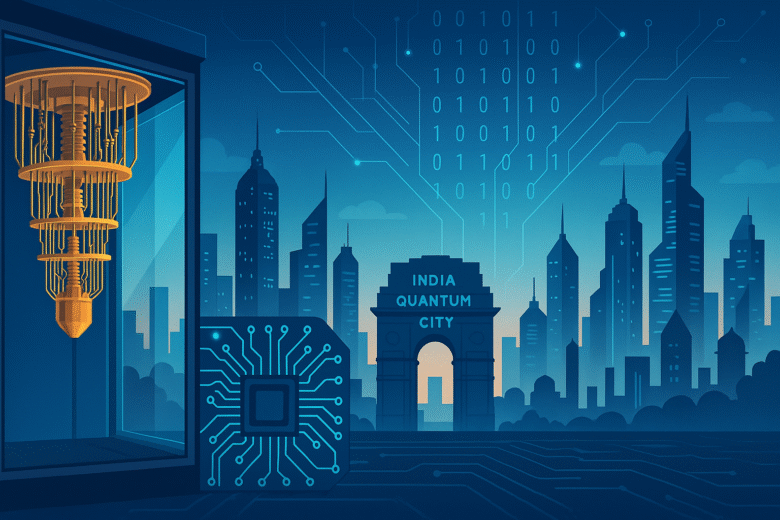Fun fact: India’s first dedicated Quantum City in Bengaluru is expected to create a USD 20 billion quantum economy by 2035. That’s huge. In this article, I examine The Promise and Peril of India’s Quantum City, exploring why this futuristic idea might be a game-changer — or a cautionary tale.
What is Being Promised
A Technological Leap
Quantum technologies — meaning quantum computing, quantum communication, quantum sensing, quantum metrology (measurement) — promise to open paths India hasn’t travelled yet. Under the National Quantum Mission (NQM), the plan is not just theoretical: they aim to seed R&D (research & development), build infrastructure, and scale up.
Big Economic Upside & Jobs
The state of Karnataka has committed ₹1,000 crore under its Quantum Mission, with a goal to build a USD 20 billion quantum economy by 2035. Part of this plan is to build “Quantum City” (often called Q-City) with startup incubators, hardware parks, fabrication facilities, high-performance computing centres, etc. This translates into opportunities for engineers, researchers, technicians, but also for ancillary sectors: supply-chain, real estate, and services.
Strengthened Research & Security
India’s National Quantum Mission (NQM) has a large budget (~₹6,003.65 crore for 2023-24 to 2030-31) to drive quantum R&D & applications. Part of the promise is that quantum communication (for instance, quantum key distribution), quantum-grade sensors, etc., would make many systems more secure. Also, research hubs and technical groups will be set up across states to decentralize the capability.
Global Positioning & Innovation Leadership
Having Quantum City will help Bengaluru (and India) not just catch up but possibly lead in certain niches of quantum tech. It can attract global talent, multinational investment, and foster industry-academia partnerships. The prestige of being a quantum tech leader has real soft power and a hard economic impact.

Spillover to Public Good
Quantum technology is not just for labs and big tech companies. It has applications in healthcare diagnostics, environmental sensing (e.g., pollution sensors), agricultural prediction (weather, pests), infrastructure monitoring, etc. The story from places like Amaravati shows how quantum and AI are being envisioned together to solve local, practical problems.
What Are the Perils
Infrastructure & Financing Challenges
It’s one thing to declare “Quantum City”; another to build ultra-clean rooms, cryogenic equipment, reliable cooling, state-of-the-art hardware, and precision fabrication. Costs are huge, and maintenance is ongoing. There is a risk of cost overruns and delays. If funding dries or is misallocated, the infrastructure may lag or remain underutilized.
Scarcity of Skills; Brain Drain
Quantum engineering, quantum materials, quantum algorithms—you name it—these require advanced expertise. India has good engineers and physicists, but quantum tech demands very specialised knowledge and sustained training. If working conditions, salaries, and research culture aren’t strong, many of the best may leave for labs abroad.
Hype vs Reality
Quantum computing hasn’t yet delivered general-purpose quantum advantage in many real-world tasks. Many promises are long-term. If expectations are set too high (e.g., solving large-scale optimization problems overnight), disillusionment may follow. Investors may pull back if results are slow or incremental.
Equity & Access
If Quantum City becomes a hub for elite universities, select startups, and only big companies, it might widen the divide. Rural India, small institutions, and underprivileged groups may get left behind. Quantum tech promises must translate into inclusive benefits.
Regulation, Security, Ethical Risk
Quantum encryption, communication, and sensing can be powerful tools, but they also have potential for misuse. Without clear legal, ethical, and regulatory frameworks, there could be privacy risks, surveillance misuse, or geopolitical tensions.
Vendor Lock-in & Technological Choice
If Quantum City invests heavily in certain platforms (say, superconducting qubits, particular cooling technologies, specific foreign vendors), and those turn out to be less efficient or scale poorly, India might end up locked into sub-optimal tech. Developing supply chains and local capability is crucial.
Case Studies & Comparisons
Amaravati Quantum Valley
Andhra Pradesh is doing more than talk: it is building India’s first Quantum Reference Facility, investing ~₹40 crore for testing, benchmarking, and characterisation of quantum components. Also, Amber Enterprises is investing ~₹200 crore in a Quantum Cryogenic Components Facility.
These are components critical to hardware-level quantum development. Moreover, startup QPiAI is collaborating to establish an 8-qubit quantum computer in Amaravati, targeting student research and public good (agriculture, healthcare, etc.).
National Quantum Mission (NQM)
This central mission is backing thematic hubs across states, technical groups, startup calls, etc. Its budget and structure show India is serious. But large-scale coordination, state vs centre roles, and policy consistency will be tested.
Karnataka’s Q-City
Karnataka has sanctioned about 6.17 to 6.2 acres of land in Hesaraghatta, Bengaluru, for Quantum City. The goal: labs, hardware park, incubators, etc., under the larger ₹1,000 crore Quantum Mission. The plan is to develop an ecosystem that supports 100+ startups, with PhD fellowships, research labs, high-performance computing, etc.
Conclusion
In the end, The Promise and Peril of India’s Quantum City is not just about technology—it’s about ambition, patience, and responsibility. The promise is immense: cutting-edge science, economic opportunity, global leadership, societal benefits. The peril is in over‐promise, underperformance, inequity, or misallocation.
If India’s Quantum City is to succeed, it needs more than grand announcements. It needs:
- Clear, transparent milestones and accountability
- Strong investment in people—training, retention, opportunity across regions
- Indigenous manufacturing and supply chains, so we’re not always importing core parts
- Regulatory and ethical frameworks before things go live
- Ensuring benefits reach the many—not just the few
Author’s Note
I’m not just cheering from the sidelines. I believe quantum tech could transform India—but only if we see through the glitter, plan for the heavy lifting, and insist that this future serves everyone. Let’s stay alert and hopeful.
G.C., Ecosociosphere contributor.
References and Further Reading
- National Quantum Mission (NQM) details — [DST, Government of India: National Quantum Mission page] Department Of Science & Technology
- Karnataka clears land for Quantum City, target USD 20 billion economy — [The Quantum Insider article] The Quantum Insider
- Karnataka approves 6.17 acres in Hesaraghatta for Q-City — [Economic Times: Karnataka Quantum City near Bengaluru] The Economic Times
- India’s first Quantum Reference Facility in Amaravati — [Times of India: Amaravati Quantum Reference Facility story] The Times of India
- Quantum Valley & QPiAI collaboration — [Times of India: Quantum Valley boosting innovation] The Times of India
- Karnataka Quantum Mission announcement (₹1,000 crore) — [Quantum Computing Report: Karnataka Mission launch] Quantum Computing Report





Comments
I love your blog.. very nice colors & theme. Did you create this website yourself? Plz reply back as I’m looking to create my own blog and would like to know wheere u got this from. thanks